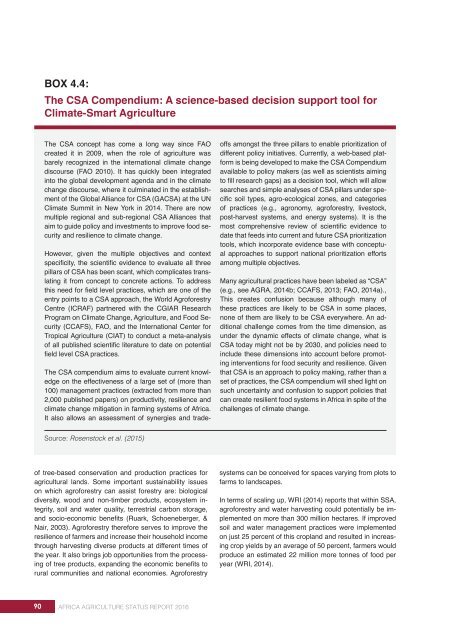AFRICA AGRICULTURE STATUS REPORT 2016
AASR-report_2016-1
AASR-report_2016-1
You also want an ePaper? Increase the reach of your titles
YUMPU automatically turns print PDFs into web optimized ePapers that Google loves.
BOX 4.4:<br />
The CSA Compendium: A science-based decision support tool for<br />
Climate-Smart Agriculture<br />
The CSA concept has come a long way since FAO<br />
created it in 2009, when the role of agriculture was<br />
barely recognized in the international climate change<br />
discourse (FAO 2010). It has quickly been integrated<br />
into the global development agenda and in the climate<br />
change discourse, where it culminated in the establishment<br />
of the Global Alliance for CSA (GACSA) at the UN<br />
Climate Summit in New York in 2014. There are now<br />
multiple regional and sub-regional CSA Alliances that<br />
aim to guide policy and investments to improve food security<br />
and resilience to climate change.<br />
However, given the multiple objectives and context<br />
specificity, the scientific evidence to evaluate all three<br />
pillars of CSA has been scant, which complicates translating<br />
it from concept to concrete actions. To address<br />
this need for field level practices, which are one of the<br />
entry points to a CSA approach, the World Agroforestry<br />
Centre (ICRAF) partnered with the CGIAR Research<br />
Program on Climate Change, Agriculture, and Food Security<br />
(CCAFS), FAO, and the International Center for<br />
Tropical Agriculture (CIAT) to conduct a meta-analysis<br />
of all published scientific literature to date on potential<br />
field level CSA practices.<br />
The CSA compendium aims to evaluate current knowledge<br />
on the effectiveness of a large set of (more than<br />
100) management practices (extracted from more than<br />
2,000 published papers) on productivity, resilience and<br />
climate change mitigation in farming systems of Africa.<br />
It also allows an assessment of synergies and tradeoffs<br />
amongst the three pillars to enable prioritization of<br />
different policy initiatives. Currently, a web-based platform<br />
is being developed to make the CSA Compendium<br />
available to policy makers (as well as scientists aiming<br />
to fill research gaps) as a decision tool, which will allow<br />
searches and simple analyses of CSA pillars under specific<br />
soil types, agro-ecological zones, and categories<br />
of practices (e.g., agronomy, agroforestry, livestock,<br />
post-harvest systems, and energy systems). It is the<br />
most comprehensive review of scientific evidence to<br />
date that feeds into current and future CSA prioritization<br />
tools, which incorporate evidence base with conceptual<br />
approaches to support national prioritization efforts<br />
among multiple objectives.<br />
Many agricultural practices have been labeled as “CSA”<br />
(e.g., see AGRA, 2014b; CCAFS, 2013; FAO, 2014a).,<br />
This creates confusion because although many of<br />
these practices are likely to be CSA in some places,<br />
none of them are likely to be CSA everywhere. An additional<br />
challenge comes from the time dimension, as<br />
under the dynamic effects of climate change, what is<br />
CSA today might not be by 2030, and policies need to<br />
include these dimensions into account before promoting<br />
interventions for food security and resilience. Given<br />
that CSA is an approach to policy making, rather than a<br />
set of practices, the CSA compendium will shed light on<br />
such uncertainty and confusion to support policies that<br />
can create resilient food systems in Africa in spite of the<br />
challenges of climate change.<br />
Source: Rosenstock et al. (2015)<br />
of tree-based conservation and production practices for<br />
agricultural lands. Some important sustainability issues<br />
on which agroforestry can assist forestry are: biological<br />
diversity, wood and non-timber products, ecosystem integrity,<br />
soil and water quality, terrestrial carbon storage,<br />
and socio-economic benefits (Ruark, Schoeneberger, &<br />
Nair, 2003). Agroforestry therefore serves to improve the<br />
resilience of farmers and increase their household income<br />
through harvesting diverse products at different times of<br />
the year. It also brings job opportunities from the processing<br />
of tree products, expanding the economic benefits to<br />
rural communities and national economies. Agroforestry<br />
systems can be conceived for spaces varying from plots to<br />
farms to landscapes.<br />
In terms of scaling up, WRI (2014) reports that within SSA,<br />
agroforestry and water harvesting could potentially be implemented<br />
on more than 300 million hectares. If improved<br />
soil and water management practices were implemented<br />
on just 25 percent of this cropland and resulted in increasing<br />
crop yields by an average of 50 percent, farmers would<br />
produce an estimated 22 million more tonnes of food per<br />
year (WRI, 2014).<br />
90 <strong>AFRICA</strong> <strong>AGRICULTURE</strong> <strong>STATUS</strong> <strong>REPORT</strong> <strong>2016</strong>


